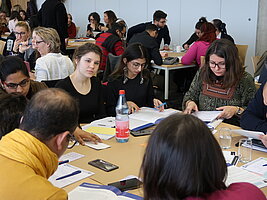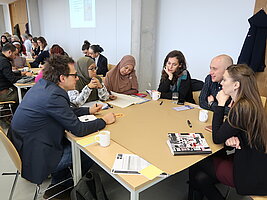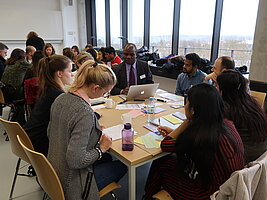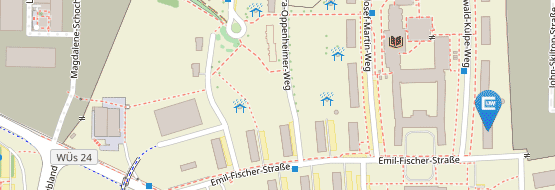World Café



Aims of the method/strategy
- to reflect on the role of power balance in education and training
- to figure out how power can act in an educational context
- to figure out how teachers and students can manage their power
Setting
Classroom, mobile chairs, small tables
Type and name of the course, curriculum, number of students in which the teaching practice was exercised:
Methodology of training, bachelor’s course in educational sciences at University of Padua, 18 attending students
Description of the method/strategy
We used World Café to discuss a very challenging and thorny topic with bachelor’s students, namely how both teachers and students use power in educational contexts.
Performing this teaching practice requires putting up a number of posters with questions (same question or different questions for each group) focused on the topic the student groups are invited to discuss.
In this specific bachelor’s course, the process involved the following steps:
- Preparing in advance three posters (one for each group) on which we wrote the same question, made of two sub-questions: ‘How do teachers use power in classroom?’ ‘How do students use power in the classroom?’
- Explaining the method to the class (activity, number of groups, timing, rounds, output)
- Organising the classroom setting with three different tables and chairs in a circle. There was a poster on each table and some markers of different colours.
- Dividing the class into three groups of 6 members each.
- Engaging in five minutes of discussion in each group for each of the three rounds (Every five minutes, the groups had to switch tables. In each group, one member was named the ‘leader’ of the group and had to present the results of his/her group discussion to the group of guests and to provide input for continuing the discussion with the new group members. This change of groups was repeated until all the three groups had moved to each table.)
- Summing up the results: The ‘leader’ of each group had the task to make a synthesis of the key aspects that came to light during the three rounds of discussion.
Materials required
Tables (round, if possible), markers, flipchart sheets
Origin and theoretical framework
This strategy was created in 1995 by a small group of business and academic leaders in California. They met at the home of Juanita Brown and David Isaacs, split into two groups of about half a dozen people at separate tables, and started to discuss the topic of their meeting, writing their insights down on paper tablecloths. From time to time, the two groups switched tables to create more connection and to go deeper into the discussions. From the table conversations, they noticed that the emerging patterns in their thinking enriched subsequent rounds of conversation. They observed that the quality of collaboration appeared to be transformed by the experience of ‘collective intelligence (Brown & Isaacs, 2002/2014).
From then on, they experimented with the method many times, identifying its seven principles: to set the setting/context, to create a hospitable space, to explore questions, to encourage participants’ contribution, to connect the different perspectives, to listen together for patterns and insights, to share collective discoveries.
World Café is a strategy to support both the social development of knowledge and the community of practice development (Wenger, 1998). The theoretical framework of reference is constructivism, which recognises the value of social and shared knowledge development and the importance of the role of people involved in the processes (Duffy & Jonassen, 1992; Vygotsky, 1978).
Risks and advantages
Advantages:
- World Café sessions produce a high quantity and quality of contents, encouraging discussion and debate;
- World Café can be used with a high number of people;
- World Café requires very little materials;
- World Café can be addressed to very different targets.
Risks:
- Time management within the group to ensure everyone can talk and share ideas. One tip to ensure everyone’s active participation is providing a small object (e.g. a stone) and inviting the host and the group members to ensure that everyone receives it during the session;
- Wording of questions: if they are too narrow, they don’t provide an effective and challenging stimulus;
- Since the World Café method encourages debate and awareness of an issue, it is important in the organizational setting to propose it when the session can be followed by actions and the organisation can take charge of the issue.
Possible variations
We used two variations:
- Same question for all tables: preferable with small groups (10-12 people, 3 rounds max to offer each one the chance to discuss the same topic with everyone, e.g. 3 groups, 3 rounds)
- Different questions for each table: preferable with more than 10-12 people, but effective with small groups as well.
We proposed the strategy with different targets. We wanted
- bachelor’s students to reflect on power issues,
- trainers and leaders to reflect on generic skills: what they are, if and how they can be trained, and so on,
- HE teachers to reflect on innovative teaching strategies and encourage the creation of a faculty learning community.
Other examples where you think it could be used
- with children, in a creative, divergent session to explore local theories about phenomena and topics,
- at the end of a course as a formative assessment for learning group activity to sum up course contents.
Recommendation
First, be sure you have tables, otherwise it is very uncomfortable for people to write on the sheets. Second, point out that World Café is designed to encourage reflection and discussion: no right answers are expected but different perspectives and points of view. Third, formulate challenging, open-ended questions: the more open and challenging they are, the more people will discuss and debate. Fourth, offer nice and fancy materials, with adults as well: markers, stickers, and everything they can use to sketch on the sheets. If you have the chance, provide candy or chocolate, above all in a formal setting: students will be very surprised!
Several recommendations and tips are provided in the following materials:
- World Café Website:
References
Brown, J., & Isaacs, D. (2014). Das World Café.
Brown, J., & Isaacs, D. (2008). The world cafe: Awakening collective intelligence and committed action. In M. Torvey (Ed.), Collective intelligence: Creating a prosperous world at peace (pp. 47–54), Virginia: Earth Intelligence Network.
Brown, J., & Isaacs, D. (1996). Conversation as a core business process. The Systems Thinker, 7(10), 1-6.
Contact persons
Concetta Tina ( concetta.tino@unipd.it )
Monica Fideli ( monica.fedeli@unipd.it )


